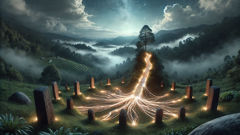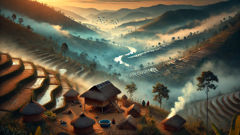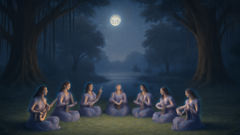Introduction
High above the rounded green shoulders of Meghalaya, where fog pours like milk between the ridges and clouds become a second landscape, the Khasi people still speak of a time when the distance between the heavens and the hills was measured not in longing but in steps. This is the story of a divine ladder—an arch of woven light and living rungs—that descended from the bright court of the One Above and rested its base within a sacred glade. In that early age, the air tasted of rain and promise. Children of the earth could climb to the place where the ancestral voices lived, come back with melodies and counsel, and then return again. It is a legend braided into the oldest songs, a memory held inside living root bridges and the hollows of banyan trees. As the hill-folk tilled their terraces and tended their sacred groves, the ladder’s existence shaped their names, their laws, and their ways of being with the natural world. This tale gently unfolds how the ladder came, why it was lost, and what was left behind: not only people and place, but customs, warnings, and a patient, stubborn reverence for the sky and the soil that together sustain life.
When Heaven Touched the Hills
Long before the first terraced gardens carved the slopes, the story goes, the world was kinder and less divided. The hills themselves were young and soft, their ridges still learning to fold into the rain. Rivers moved like conversations, altering course when they pleased. In that first season, the One Above—named in whispers, held in the quiet pronouncements of elders as the Great One, the Beloved Above, or simply U Blei—leaned down and saw a lonely brightness in the valley that would become home to a people who had not yet been taught how to keep the world from tiring. Moved by a tenderness that in later ages would be sung as mercy and named as law, the One Above sent a ladder.
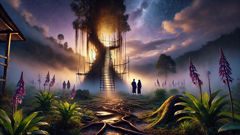
The ladder was not wood or metal. It was a thing woven of starlight and root-sense, braided threads that seemed both woven by the sky and grown from the earth. Each rung was warm as a hearth and cool as a spring. When it touched the hills, moss curled around its feet and orchids arched their heads to drink its light. The first people—small, curious, and quick to smile—found it, and at once their lives widened. They climbed to the bright place above and returned with stories of rivers of light, with advice on how to steward seeds, with knowledge of which trees to honor, which stones to mark, and which songs would make rain come sooner.
Those early climbs reshaped how people lived. Families named children after the high places they visited; clans traced their lineage to the voices they had met on the upper rungs. The ladder made the idea of justice simple: grievances could be carried upward, and the Great One listened. The economy of giving and receiving—gift for gift, song for shelter—became a public art. When a child was born, elders would lead the newborn to the glade to learn the first syllable of a name that the One Above might approve. When crops failed, envoys climbed to ask why; when water wanted new channels, the ladder’s counsel guided small engineers to carve terraces and channels with humility and care.
In these narratives, the ladder is depicted alternately as mercy and mirror. Merciful because it carried the teachings that allowed the people to thrive. A mirror because what was brought down from above revealed what the people already were—kind, curious, and sometimes dangerously unguarded. The elders who kept the lore taught restraint: the ladder connected but did not make the human heart immune to vanity. They told of one age when the hill-dwellers asked for more than instruction; they asked for permanence. A few among them climbed higher and lingered, returning with crowns of cloud and speech that tasted like dominion. The songs they sung back in the villages swelled into boasting, and boasting, said the stories, is fertile ground for rupture.
The breaking of the ladder is told in many tones across valleys and families: sometimes as a sudden snapping of a single great braid of light; sometimes as a slow drifting upwards, where the rungs unstitched themselves like old fabric; sometimes as a deliberate withdrawal of the One Above. In most versions, a moment of human forgetting—pride, greed, or the misuse of heavenly counsel—led to change. One tale insists that a leader tried to pull the ladder lower, binding rungs with iron and insisting that the sky should be practical and useful like a granary. Another says that the Great One, seeing how easily gifts could harden into claims, unmade the ladder out of sorrow, drawing back not in anger but in grave sadness. When the connection severed, the heavens receded to their heights and the hills were left with footprints, names, and the memory of a light that once brushed leaf and hair.
After the retreat, life did not simply return to what it had been. The knowledge that had been given remained: how to plant in rows that followed the breath of wind, how to coax water into terraces, which herbs eased fever and which stones damped anger. With the ladder gone, however, the people learned to speak with the land rather than through it. Sacred groves were established to mark the places where the ladder had touched. Stones were set, songs codified, and rituals invented to honor both the gift and the warning. Families continued to sing the climbing-songs to shepherd memory, and elders would sometimes, on clear nights, stand at the glade and hum the old cadence as if to coax the sky into remembering them.
The myth does more than explain disappearance. It shapes behavior. Where the ladder had been, laws emerged that prized reciprocity and restraint. A community that had once received direct instruction now learned to reason with each other and with the hills. Leaders were chosen not because they had seen the bright court but because they could listen to the voices beneath the soil—the elders who tended the living root bridges, the women who knew the weather from the way the spiders rested, the young who carried songs like small bright things. Memory of the ladder was a living curriculum, embedded in everyday acts and in the slow art of tending. Even in the rustle of a bamboo grove there remained an echo: from heaven to hill was a short thing once, and though the ladder was gone, its teaching lingered like a scent.
It is important in retellings to preserve the humility voiced in the lore. The ladder was not a tool of domination but a gift that taught stewardship. The people who cherished it learned that sky and soil are not rivals; they are partners in the slow business of keeping life. That lesson underpins why sacred groves remain unharvested, why particular rivers are left with stones piled as small altars, and why certain families continue to recite the climbing-songs at births, weddings, and funerals. The story is less about a literal bridge and more about a covenant: an agreement to remember what generosity looked like and to avoid mistaking bounty for entitlement. Today, when hikers pass through mist and living root bridges, when the younger generations learn both modern schooling and the old songs, the legend of the ladder persists as a gentle teacher. It is not a consoling tale that erases loss. Rather, it is a resilient cord that ties communal practices to an origin, a moral map for living lightly on a world that was, for a time, close enough to touch the stars.
After the Ladder: Memory, Law, and the Living Landscape
When the ladder withdrew, the people of the hills did what people always do when the extraordinary becomes memory: they made ordinary the lessons and extraordinary the memory. Practical knowledge—how to drain a terrace when monsoon threatened to tear it, how to plant companion crops so soil would not leave, how to build houses that breathed with the seasons—remained in daily hands. Songs that once accompanied a climb now accompanied planting. The hymn that the elders hummed for rain was the same melody mothers hummed into infants’ ears. The ladder’s touch had not been a simple transmission of technology; it had taught a way of seeing the world as an ongoing conversation. This is where ecology and ritual braided together.
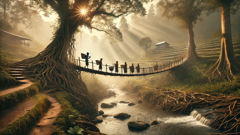
Sacred groves, known in broader terms across the region but given a particular tenderness here, became living archives. Trees in those groves were left to grow with minimal interference. People came to these places to settle disputes, to mark time, to bind intentions with string and song. Each grove was a chapter in communal memory: a place where the ladder had once been felt underfoot, a place where an ancestor had received counsel, a place whose air smelled of moss and old promises. The law that grew from the ladder’s lessons was not carved on stone but spoken and sung and taught around hearths. It emphasized reciprocity, a practice as mundane as sharing fish from a common pool and as sacred as ensuring a child’s name carried both family and communal expectation.
Clans traced their ancestral seats not only in lineage registers but in place-names stitched to features of the landscape. A stream might be known as ‘the place where Lait’s child climbed’ or a rock as ‘the rung where Marjong rested.’ These names functioned as mnemonic anchors. They kept the stories anchored in soil and sound. If a young person asked about why their clan would not cut timber in a certain patch, elders replied with the anecdote of a line of people who once climbed, or the song whose last verse curtailed the appetite for quick gain. Thus folklore became law and law became habit.
The myth also offers an origin for certain rituals that outsiders might find curious. The practice of carrying a small bundle of particular leaves during a funeral walk, the custom of leaving a bowl of rice at a stream when a family first irrigated a new terrace, the dances that mimic the careful, upward stepping of climbing—each of these acts says, in gesture, 'we remember how to ask, and how to decline.' In such gestures, the community articulates a collective humility. The ladder’s withdrawal is remembered not only as loss but as an invitation. Without the ladder, the community discovered a keener responsibility: to keep channels of listening open in other ways. People learned to make their own altars of attention—careful listening to elders, attentive stewardship of water, ceremonial apologies to the land after a harvest taken in times of scarcity.
Tourists and scholars who wander into the hills today often look for relics: physical fragments of a ladder, carvings that must surely be ancient. What they find instead are subtler traces: grooves in old stones worn by generations of offerings, pinched lines of song that recur in different gatherings, and the living root bridges whose slow architecture echoes the braided rungs of the vanished ladder. The living root bridges—made by guiding the roots of rubber trees across streams until they form walkable spans—are a particularly eloquent echo. They embody the same ethic: long-term thinking, mutual shaping between human intent and natural growth, a refusal of short-term fixes in favor of patient craft. In the same way, the ladder taught a long-view of being. The bridges and the songs persuade anyone who will listen that the people learned to build what lasts by aligning with growth, not by forcing it.
There is also a contemporary layer to the legend. As towns grow and roads cut deeper into the hills, younger generations face new choices about livelihood and identity. The ladder’s story becomes a touchstone in conversations about development, preservation, and memory. Educators and environmentalists draw on the tale when encouraging sustainable practices. Artists translate the ladder into murals and installations that ask viewers to consider where their rungs would be in a world of modern speed. Musicians reinterpret the climbing-songs in contemporary tones, making them accessible without flattening their meaning. In this way, the legend remains adaptive. Its images are repurposed, not abandoned.
At its heart, the tale resists a tidy moral. It refuses the comfort of saying the ladder was taken because people were bad, or that it was withdrawn because the gods tired of humans. Instead the story invites a more complicated reading: gifts can teach; gifts can be misunderstood; memory can be preserved as law and practice. The ladder is a parable about the precariousness of intermediary gifts—those instruments that make understanding possible but which, if clutched, are turned into instruments of control. The Khasi teaching embodied in the story says: be grateful, be cautious, and above all, learn to sustain the exchange yourself. That admonition translates into a politics of care that has allowed the people of these hills to steward rich biodiversity and complex social relations.
In the end, perhaps, the ladder never entirely left. On the clearest nights, when the fog lies low and stars are sharp, villagers who look up from the glade claim to feel a hum: not a literal ladder but the after-vibration of a covenant. The hum becomes a lesson passed on to children as they learn to plant, to build, and to name. It asks them to imagine that the sky can be close, not as a claim of possession but as a call to responsibility. The legend’s true gift is not the ladder itself but the ethic that grew from its absence—an ethic that keeps people attentive to the delicate weave of gifts between sky and hill, between neighbor and neighbor, between present and future.
Conclusion
The Legend of the Khasi ladder closes not with the finality of an ending but with a steadying of purpose. Loss—if we must call the ladder’s absence a loss—produced a discipline that shaped law, craft, and song. The people of Meghalaya did not become poorer because they lost direct speech with the sky; they became different, inventing new ways to listen and new ways to answer. That evolution is the living heart of the myth. When we tell this story today—whether as a poetic retelling, a cultural study, or a guide for sustainable living—we are doing what the elders did after the ladder: transforming memory into practice, reverence into routine, and myth into a manual for good tending. The ladder’s image continues to travel, braided into murals, taught in classrooms, hummed at births and funerals, and suggested by root-bridges that remind us: bridges are made where two sides will meet halfway. The legend preserves an old wisdom for our precarious time: that gifts between worlds ask for gratitude and restraint, that memory can be a law, and that the clearest way to honor what once was is to keep its lessons alive in the ways we treat the land and one another.

